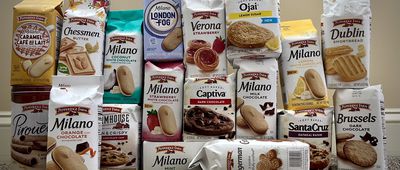Nowadays, it feels like just about anything can be delivered. Whipping up dinner and missing a key ingredient? No worries — just press a button on your phone and you'll have fresh groceries on the doorstep within an hour. Can't function without morning coffee? Someone will be right over with your daily pick-me-up.
But one chain has refused to go along, despite fierce competition from the likes of Target, Walmart, and Whole Foods: Trader Joe's. We took a look at why Trader Joe's has bucked the delivery trend — and how you can work your way around the grocery store's no-delivery policy using third-party vendors like Task Rabbit, Amazon, and Craiglist.
Does Trader Joe’s Deliver?
No, Trader Joe's does not deliver. It also doesn't offer curbside pickup or sell its products online. Founded in 1967, the grocery chain prides itself in catering to a niche market of low-key shoppers who value quality products and reasonable prices above all else. From its farm-to-table appeal and charm to its hand-drawn display boards, bell ringing, and long list of unique products, TJ's has prioritized other ways to serve its customers.
Why Doesn't Trader Joe's Offer Its Own Delivery Service?
When asked about why the company hasn't jumped on the e-commerce bandwagon — particularly at the height of the pandemic — Trader Joe's vice president of marketing Matt Sloan said in a 2020 podcast that it's complicated. "Our main focus as a company has been doing what's right for our crew members and customers for decades," said Sloan. "Creating an online shopping system for curbside pickup or the infrastructure for delivery, it's a massive undertaking."
"At Trader Joe's, the reality is that over the last couple of decades, we've invested those resources in our people rather than build an infrastructure that eliminates the need for people," Tara Miller, marketing director at Trader Joe's, said in the podcast. "The bottom line is that our people remain our most valued resource," she said. "While other retailers were cutting staff and adding things like self-checkout, curbside pickup, and outsourcing delivery options, we were hiring more crew, and we will continue to do that."
While the chain offered delivery services in New York City for a full decade, it pulled the plug on the program in 2019, citing unsustainable high costs and limited space. “Instead of passing along unsustainable cost increases to our customers, removing delivery will allow us to continue offering outstanding values … and to make better use of valuable space in our stores,” a Trader Joe's spokesperson said at the time.
For more clever life hacks and money-saving tips, please sign up for our free newsletters.
@mg4u504 Trader Joe’s delivery available daily! #personalshopper #traderjoes #grocerytok #deliveryservice ♬ original sound - Liliana , RN ❤️
How To Get Trader Joe's Groceries Delivered
But just because Trader Joe's doesn't offer its own delivery services doesn't mean you can't still get your hands on some of your favorite Trader Joe's snacks and charcuterie goodies. Here are five ways to get products from Trader Joe's delivered to your doorstep, and a closer look at the pros and cons of each:
- Trader Joe's Delivery via Amazon
Search for your desired Trader Joe's product on Amazon. If it's available, place your order as you would with any other product on the app.
Pros: Convenient and familiar for many shoppers. If you have Amazon Prime, you might not even have to pay a delivery fee.
Cons: Limited selection of Trader Joe's products. Prices may be marked up and delivery might take longer than usual. - Trader Joe's Delivery via Craigslist
Some individuals on Craigslist offer personal shopping and delivery services. If you can't find one, consider posting a gig request. Pro tip: Always be cautious when dealing with unknown parties to avoid scams and sketchy transactions.
Pros: Flexibility to get deliveries from multiple grocery stores. Some personal shoppers offer competitive rates.
Cons: Less reliable and can be time-consuming. Security concerns with unknown individuals. - Trader Joe's Delivery via TaskRabbit
TaskRabbit connects you with local "taskers" who can help you run errands, do handiwork, and complete other tasks like grocery shopping and delivery. Select the service you need from the TaskRabbit app or website and pick from the available taskers nearby.
Pros: Versatility in services. You can get same-day deliveries, not just from Trader Joe’s but also from other local stores.
Cons: Not specialized for groceries, so experiences can vary. - Trader Joe's Delivery via Dumpling
Visit the Dumpling site or app, enter your zip code, and see available personal shoppers in your vicinity. Profiles with the Trader Joe’s logo indicate that they offer products from there.
Pros: Specialized for grocery delivery. You can easily see which shoppers deliver from Trader Joe's by checking their profiles.
Cons: Limited number of shoppers in certain areas, especially if located away from bigger cities.
The Bottom Line
So, which is the best way to get Trader Joe's groceries delivered? It depends on your individual needs and preferences. If you're looking for the most affordable option, you may want to consider using a third-party delivery service like Amazon. However, if you're looking for the best possible delivery experience, you may want to consider using a personal shopper service like Craigslist or TaskRabbit.
No matter which option you choose, be sure to read the reviews of the delivery service before you place your order. This will help you ensure that you get the best possible experience.
Frequently Asked Questions
Does Trader Joe's deliver on Instacart?
No. Instacart is a popular online grocery service that links users with local shoppers for delivery from most large retailers, but it does not currently offer delivery from Trader Joe’s.
Can you order stuff online from Trader Joe's?
No. Trader Joe's does not offer online ordering, curbside pickup, or delivery through its website. The company has focused on in-store shopping experiences and does not have an e-commerce platform. However, you can use third-party vendors or hire a personal shopper to get Trader Joe's products delivered to your home.
Why isn't Trader Joe's on delivery apps?
Trader Joe's prioritizes a unique in-store experience that aims to maintain product affordability. This ensures quality control, lower overhead costs, and a simpler operational model. This is why the chain has chosen not to partner with popular delivery apps and services like Doordash and Postmates.








